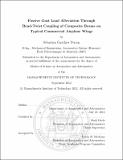| dc.contributor.advisor | Mark Drela. | en_US |
| dc.contributor.author | Gauthier Perron, Sébastien | en_US |
| dc.contributor.other | Massachusetts Institute of Technology. Dept. of Aeronautics and Astronautics. | en_US |
| dc.date.accessioned | 2013-02-15T14:39:42Z | |
| dc.date.available | 2013-02-15T14:39:42Z | |
| dc.date.copyright | 2012 | en_US |
| dc.date.issued | 2012 | en_US |
| dc.identifier.uri | http://hdl.handle.net/1721.1/77111 | |
| dc.description | Thesis (S.M.)--Massachusetts Institute of Technology, Dept. of Aeronautics and Astronautics, 2012. | en_US |
| dc.description | Cataloged from department-submitted PDF version of thesis. This electronic version was submitted and approved by the author's academic department as part of an electronic thesis pilot project. The certified thesis is available in the Institute Archives and Special Collections. | en_US |
| dc.description | Includes bibliographical references (p. 89-91). | en_US |
| dc.description.abstract | The effects of bend-twist coupling on typical commercial airplane wings are evaluated. An analytical formulation of the orthotropic box beam bending stiffness matrix is derived by combining Euler-Bernoulli beam theory and classical laminated plate theory. The out-of-plane displacement due to the twist of the cross section is modeled by a bilinear warping function. The analytical model is evaluated and validated against finite element analysis and experimental results. The model can accurately predict the twist and deformation of orthotropic box beams within 15% of the benchmarking data and provides best results for beams of higher aspect ratios and with layup angles below 30 degrees. Airplane level aero-structural simulations are performed in ASWING using models of Boeing's 737 and 777. The composite wings are sized for a static load increase and a set of gusts as prescribed by the FAA. Using unbalanced laminates to generate the structural coupling leads to significant strength penalties if the loading is not parallel to the laminate's fiber directions. The optimal laminate angle for which the weight saving benefits of bend-twist coupling are maximized corresponds to the wing's principal stress direction. Beyond that angle, the wings will exhibit more coupling but the laminate strength penalties are too large to be overcomed by the benefits of bend-twist coupling. The addition of coupling to the wings leads to reductions in peak spanwise bending moments in the order of 20% to 45%. It is demonstrated that the mechanism behind this reduction involves increased wing tip twist which alleviates part of the outboard wing load. This ultimately results in weight savings in the order of 2% to 4%. The findings suggest that the benefits of bend-twist coupling are more important on heavier airplanes such as the 777 due to the effects of the cube-square law. | en_US |
| dc.description.statementofresponsibility | by Sébastien Gauthier Perron. | en_US |
| dc.format.extent | 133 p. | en_US |
| dc.language.iso | eng | en_US |
| dc.publisher | Massachusetts Institute of Technology | en_US |
| dc.rights | M.I.T. theses are protected by
copyright. They may be viewed from this source for any purpose, but
reproduction or distribution in any format is prohibited without written
permission. See provided URL for inquiries about permission. | en_US |
| dc.rights.uri | http://dspace.mit.edu/handle/1721.1/7582 | en_US |
| dc.subject | Aeronautics and Astronautics. | en_US |
| dc.title | Passive gust load alleviation through bend-twist coupling of composite beams on typical commercial airplane wings | en_US |
| dc.type | Thesis | en_US |
| dc.description.degree | S.M. | en_US |
| dc.contributor.department | Massachusetts Institute of Technology. Department of Aeronautics and Astronautics | |
| dc.identifier.oclc | 825070829 | en_US |
